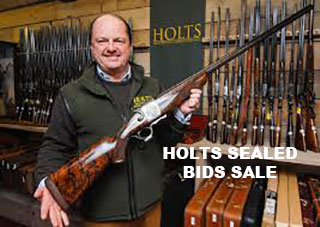Everyone has to try and squeeze what they can out of their businesses these days. Auctioneers understand this and have been re-structuring for some years now, in reaction to what is a falling market for sporting guns, perhaps a shrinking one too.
We first saw signs of this when the really big houses started sectioning off their Sporting Gun Departments. Sotheby’s cut Gavin Gardiner loose, and Thomas Del Mar. They now run independent businesses ‘in association with Sotheby’s’. I reduces the wage bill and the risk in what is a small department in their terms. The average London gun auction nets perhaps £300,000 - £500,000, while a single painting or classic Ferrari can change hands for millions.
Holt’s moved out of London to cut costs in December, holding the sale in Norfolk instead. They have also made some adjustments to their website. The most notable, from my point of view, was the introduction of a pay wall to the archive section. Now, if you want to look-up guns sold in previous auctions, you have to register and pay £35 in order to do so.

Holt’s have, by now, built up a very impressive library of well photographed and described sporting guns, spanning almost two decades of business. The archive allows one to check historical prices, the re-sale figures of the same guns, the number of guns sold from any given maker, or of any given bore size or configuration. It really is a very useful resource. Until last month it was freely accessible via Holt’s website.
I suppose Holt’s have re-evaluated this as a product that has income potential they can realise. They could be right. It is a no-cost addition to their sales, since it has to be built in any event to prepare for each auction. Dealers, collectors and journalists use the archive for research, so it has a value, just like a book or a directory. If just 5% of the regular visitors to Holt’s website sign-up, it will pay someone’s salary.
Money, however, was not the main motivation behind the move, according to Holt’s. It was designed more as a method by which trade buyers could protect sensitive information. We all know that if we buy a gun at Holt’s for £2,000, which is in need of extensive repair, as many are, there can be an issue at sale time when the punter does a quick maker and serial number search.
He sees you paid £2,000 at Holt’s and now want £5,000 from him, neglecting to appreciate commission, the cost of restoration or the need to make an honest margin in order to stay in business. All that sticks in his mind is the difference between the two figures. It is a cause of friction and has been since the internet and gun auctions became inextricably linked.
“We like to work with the Trade”, Holt’s told me, “We are all on the same side.” Although Holt’s have worked hard to attract the general public to sales to treat them as retail environments, not all guns sold in auction are suited to private purchase. A pair of Boss side-locks in the last sale make a good example. They were no good to anyone who wasn’t prepared to re-barrel them, or sleeve them at the very least. They should now disappear into the Trade and re-emerge in eighteen months or so looking beautiful and ready for a retail buyer to take on.
The anonymity the archive pay-wall now provides for these purchases is a service to gun dealers all over the country. It will be interesting to see if Gavin Gardiner and Bonham’s follow suit. I know it would be appreciated and it may even stimulate some trade buyers to re-engage with auctions.
Holt’s have probably saved £150,000 a year by moving out of London so their bottom line will improve significantly simple asa result of these adjustments, so long as they maintain their sales figures at around the same level they are now. Early indications are positive. Holt’s set a target for the sale and met it; significantly beating the figures generated by the last Kensington auction, in September.
Viewing started the Monday before the sale, with good levels of attendance on all the viewing days and a full auction room for most of the day of the sale, tailing off towards the last hour.
The economic climate remains a challenging one for auctioneers and un dealers. Gun smiths always seem to be doing well and it remains difficult to get good work done in a reasonable time-frame unless you are well connected.
There was a clear drop-off of foreign interest in the auction scene in 2016, with Germany and Italy drying-up badly in terms of buyers. The slight rise in Sterling following the Conservative election victory in December is a small negative if you are an overseas buyer, but Sterling is still well below the level it held against most currencies before the Brexit vote, so, historically American and European buyers are still in a good position.
The challenge remains to persuade vendors to part with their guns in a falling market. Few forecasters anticipate a recovery to the levels of a decade ago.
All markets go in cycles but some cycles take twenty or thirty years rather than five. Many of us will be dead before we can expect to see the prices many seem to be holding out for. Perhaps that is what it will take to see these collections hit the auction rooms again. Gun collecting is predominantly and older gentleman’s hobby and a lot of them are getting very old indeed.
Published by Vintage Guns Ltd on




